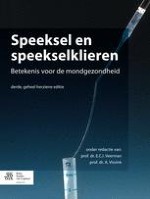2014 | OriginalPaper | Hoofdstuk
2. Vorming en secretie van speeksel
Auteurs : E.C.I. Veerman, A.J.M. Ligtenberg
Gepubliceerd in: Speeksel en speekselklieren
Uitgeverij: Bohn Stafleu van Loghum
Samenvatting
-
Speeksel wordt geproduceerd door verschillende speekselklieren. Daarnaast bevat mondvloeistof een kleine hoeveelheid serumeiwitten, die via de creviculaire vloeistof in de mondvloeistof terechtkomen.
-
De grootste bijdragen aan speeksel leveren de oorspeekselklieren (gl. parotise), de onderkaakspeekselklieren (gl. submandibulares) en de speekselklieren onder de tong (gl. sublinguales).
-
Anorganische bestanddelen variëren sterk, afhankelijk van stimulatie; vooral Na+, K+, Cl- en HCO3 -. Minder sterk variëren Ca2+, Mg2+ en fosfaat.
-
De ionensamenstelling van primair speeksel lijkt op die van bloedplasma: door resorptie in het afvoerkanaal worden Na+- en HCO3 --ionen geresorbeerd en K+-ionen gesecreteerd. Gevolg van deze resorptieprocessen is dat de mondvloeistof hypotoon is ten opzichte van serum.
-
Speekselsecretie is een neuronaal gereguleerd proces. Secretie van eiwit door acinaire cellen wordt gestimuleerd door adrenerge stimuli. Cholinerge stimuli zetten cellen aan tot secretie van water en ionen.
